In NurseMind, much of the data is visible to all users. This includes all shifts belonging to the "hospital" named "Generic". Users "join" hospitals. Everyone belongs to the "Generic" hospital.
Some data has restricted access. These are the shifts, protocols, tasks, precautions, and quick references (SPTPQR) that belong to a specific hospital. To access them, you join that hospital.
 Let's say you work at Mount Zion Hospital in San Francisco. To use its SPTPQR, open the "Profile" screen.
Let's say you work at Mount Zion Hospital in San Francisco. To use its SPTPQR, open the "Profile" screen.
Next, tap "My Hospitals".
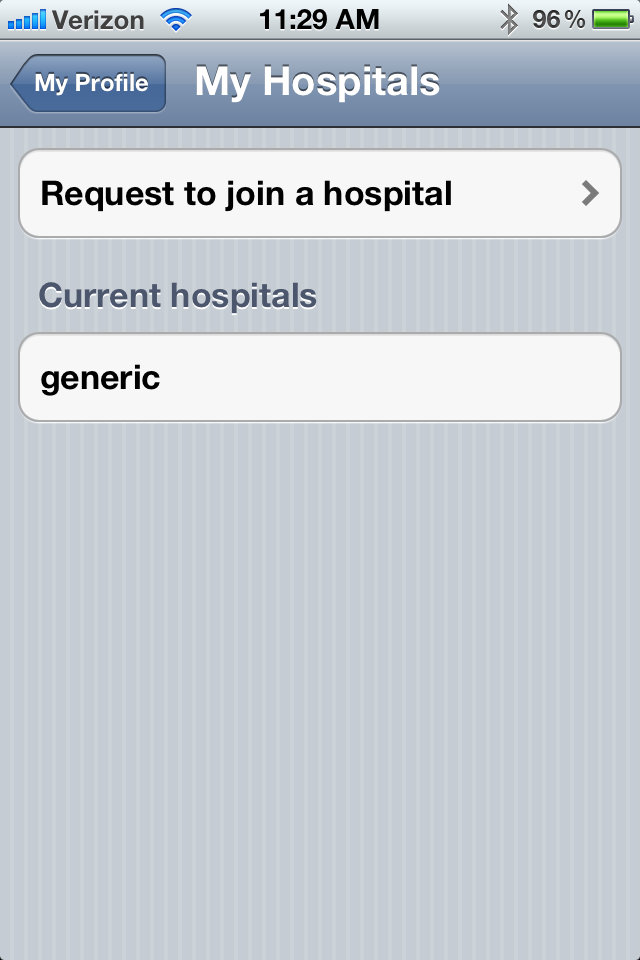 Next, tap "Request to join a hospital".
Next, tap "Request to join a hospital".
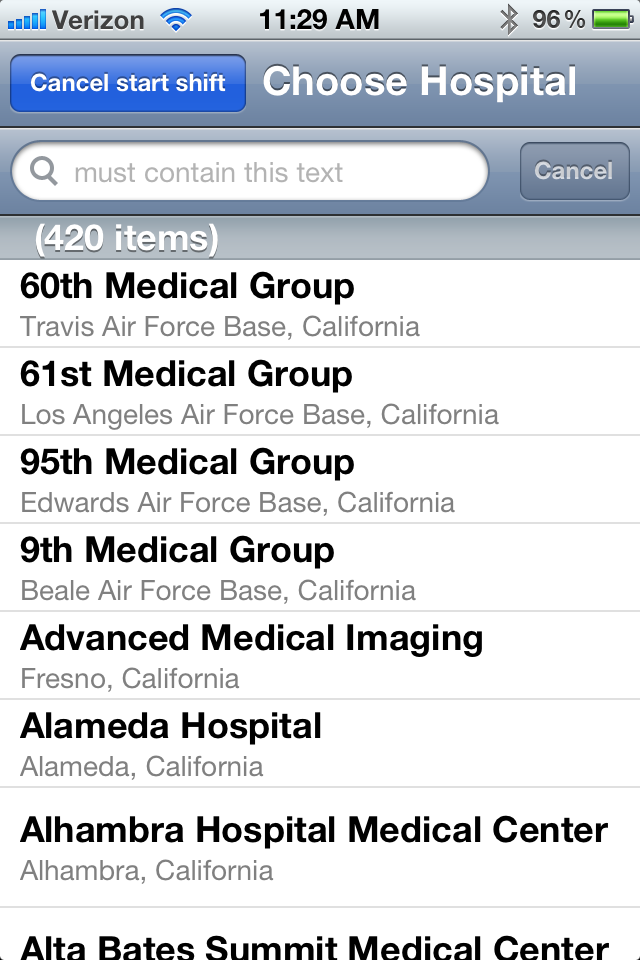 A list of the 7000 (and growing) US hospitals is offered. (In this image, only the 420 California hospitals are shown.) Scroll down to the one you wish to join, or enter part of its name in the search box to jump to it in the list. If the one you need is nonetheless absent, you can add it in the "Edit Data" area of the app or ask us to do it for you.
A list of the 7000 (and growing) US hospitals is offered. (In this image, only the 420 California hospitals are shown.) Scroll down to the one you wish to join, or enter part of its name in the search box to jump to it in the list. If the one you need is nonetheless absent, you can add it in the "Edit Data" area of the app or ask us to do it for you.
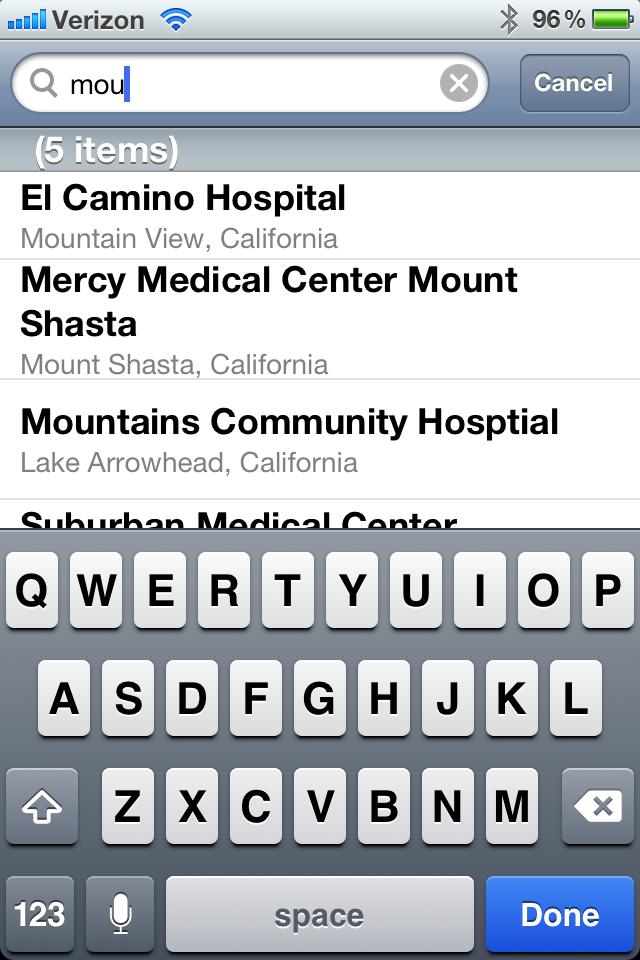 To find Mount Zion in the list, you could scroll down and down and down... or you could type part of the hospital's name in the search box. Here, we have entered "mou" (part of the word "Mount"). Now, only those hospitals with the letters "mou" in their names or locations are shown.
To find Mount Zion in the list, you could scroll down and down and down... or you could type part of the hospital's name in the search box. Here, we have entered "mou" (part of the word "Mount"). Now, only those hospitals with the letters "mou" in their names or locations are shown.
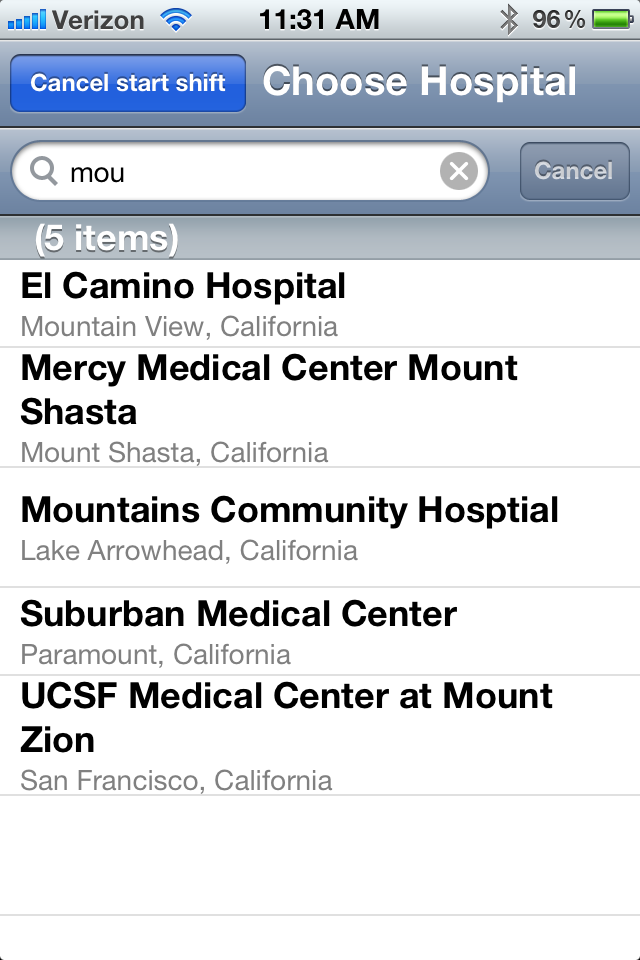 Now it's easy to find Mount Zion.
Now it's easy to find Mount Zion.
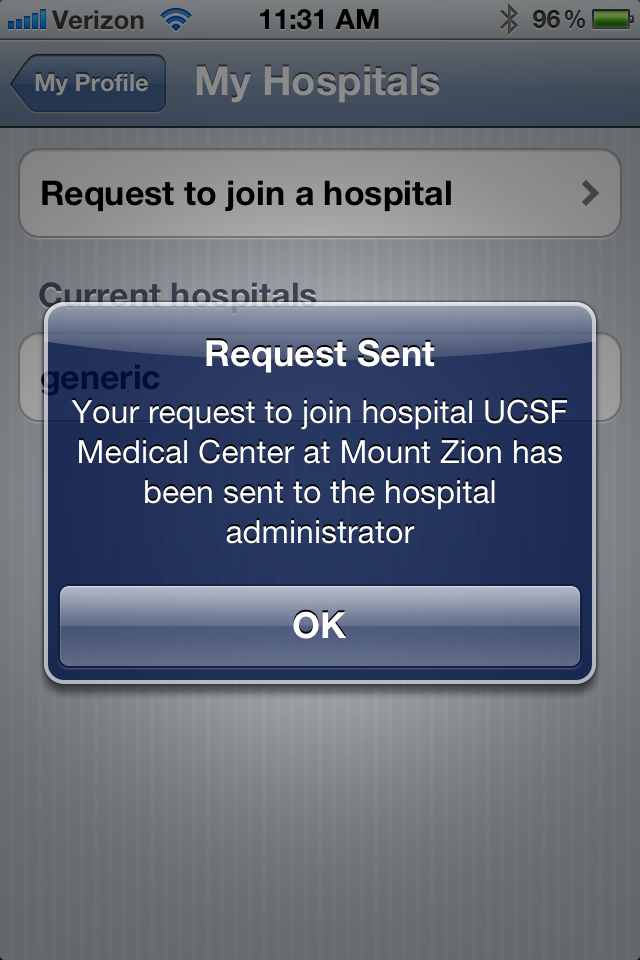 Tap Mount Zion and see that your request to join has been sent to the hospital's administrator, usually a nurse manager. Once that person approves your request, access is granted.
Tap Mount Zion and see that your request to join has been sent to the hospital's administrator, usually a nurse manager. Once that person approves your request, access is granted.
What Data is Protected
Even though NurseMind uses no PHI data, some of the information in it is sensitive. Therefore, the app and its databases incorporate a privacy protection/access control scheme.
Why bother to have access controls? Why not share everything with everybody? Two reasons:
1. A nurse's work history and performance is his/hers alone. It is shared only to the extent she/he chooses. Which tasks she/he's completed (or not), which were done on time (or not), and so on, is private. No nurse wants Big Brother looking over his/her shoulder. Thus, our explicit and unconditional policy is that each nurse's data is visible only to him or her except as follows:
a) Real-time activity data for nursing students may be overseen by clinical faculty.
b) De-identified nursing activity data, aggregated on a unit-wide basis, may be viewed by the unit's nursing administrator (about whom more below) for the purpose of unit performance statistics, not for nurse performance evaluation. Under no circumstances will the performance data regarding any individual non-student nurse be revealed to anyone but that nurse.
2. Some hospitals consider their protocols to be their exclusive intellectual property. Thus, the hospital can decide whether a protocol is to be shared with everyone or reserved for use solely by the members of that hospital. Also, information such as door codes and phone numbers (termed "Quick Refs") may be viewed only by members of the hospital.
NurseMind's access restriction mechanism protects both of these.
Levels of Protection
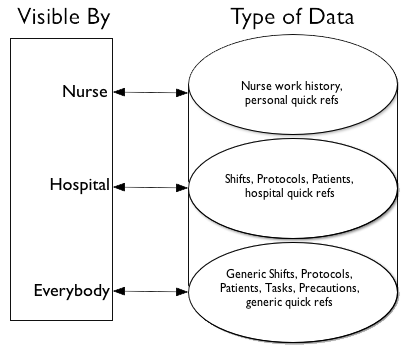
Information in NurseMind -- work shifts history, protocols, quick refs -- have three levels of access:
1. Information that is visible only by a single nurse.
2. Information that is visible by all the nurses in a hospital.
3. Information that is visible to all NurseMind users.
Who Manages These Protections and How
The highest level of security applies to data that is visible by only a single nurse.
A computer password, for example, has this level of security.
The middle level of security protects data that is visible to everyone who works in a particular hospital and to no one else.
Being a member of that hospital endows a user with access to its shifts, protocols, and quick refs. For example, it is appropriate for internal phone numbers and door codes to have this level of protection. These data are withheld from people who do not work in that hospital.
The ability to grant hospital-wide access to data creates a form of social networking that benefits the members of that hospital. For example, a nurse can create a new protocol and then share it with the other nurses in her or his hospital.
For the purposes of the app, every hospital has at least one nursing administrator. The role of the nursing administrator is to grant or deny requests for membership in that hospital, and to approve or reject requests that information (shifts, protocols, quick refs) be shared hospital-wide.
The third and lowest level is for things like medical acronyms that are ok to share with anybody.
When you create a shift, protocol, or quick ref, you can decide which level of access to give it. There is one hospital -- named "generic" -- that has a special property. Every user belongs to it. Any shift, protocol, or quick ref that belongs to this hospital is thus visible to all users. If you create one of these things and wish to share it with all nurses in every hospital, request to share it with the generic hospital. The system administrators will then review it to make sure it's not inappropriate, approve the request, and render it visible to all NurseMind users. This is a form of social networking that benefits everyone.
Quick Refs
Quick references ("quick refs") are small pieces of information that you occasionally need on the job and cannot always memorize. These include phone numbers, passwords, door codes (combination locks), and acronyms. Some of these -- such as your computer passwords -- belong to you only and are not shared. Others such as phone numbers are shared with other workers in your hospital but not with the outside world. Yet others -- such as common acronyms like RACE and PASS -- are not private so they are shared with everyone.
Here is how to use quick refs. When you create a quick ref it is automatically private to you. At any time, you can choose to share it with any hospital that you are a member of. Hospital administrators can review shared quick refs and "un-share" them if they decide that sharing is not appropriate.
The "Generic" Hospital
Generic data (shifts and protocols created by Nurse Tech that belong to the "hospital" named "Generic" and are visible to all users) serve a special purpose. Often, these suffice for your hospital and you may use them when you work your shifts. If your hospital needs fine-tuned or unique SPTPQR (shifts, protocols, tasks, precautions, and quick references), the best strategy is to copy a generic shift or protocol and then edit it. Edit it by adding and deleting tasks and changing task deadlines and durations.
Newly created SPTPQR are private by default. To share one (i.e. make it not be private), go to the "Advanced" screen, then "Edit Data", and then select the type of the object and click on it. Then you can choose the hospital with which you wish to share it. Of course, you can share it only with a hospital of which you are a member. To share it with a second hospital, repeat this process.
